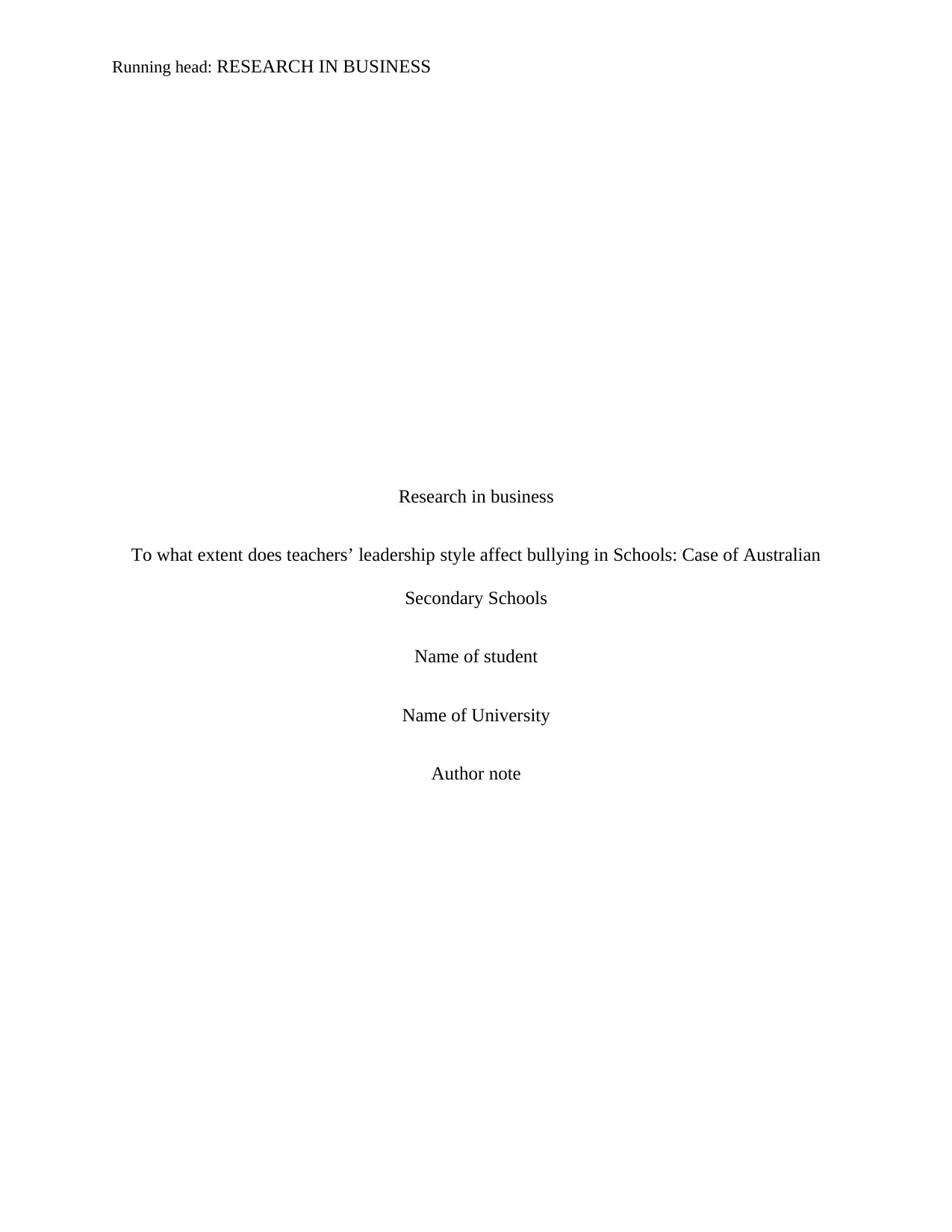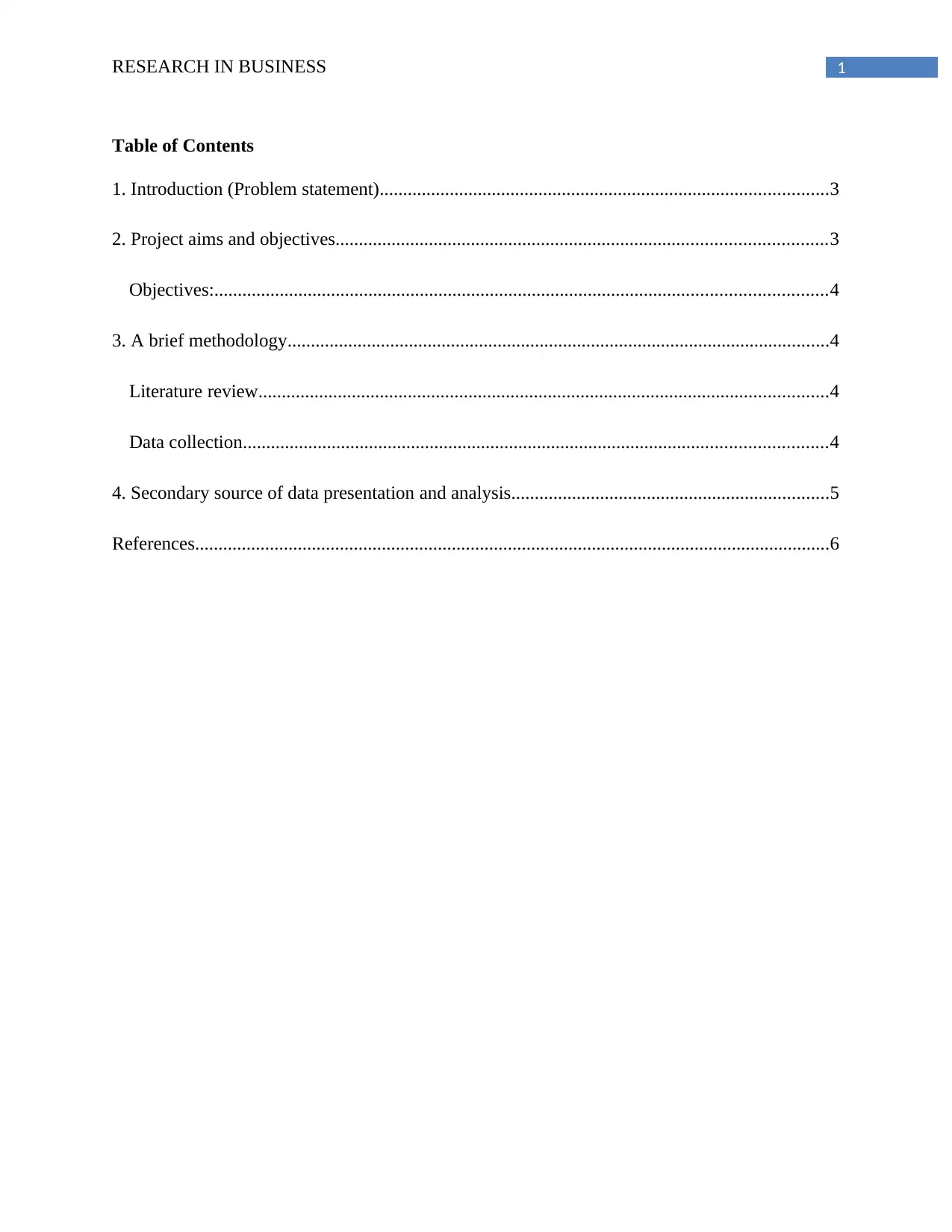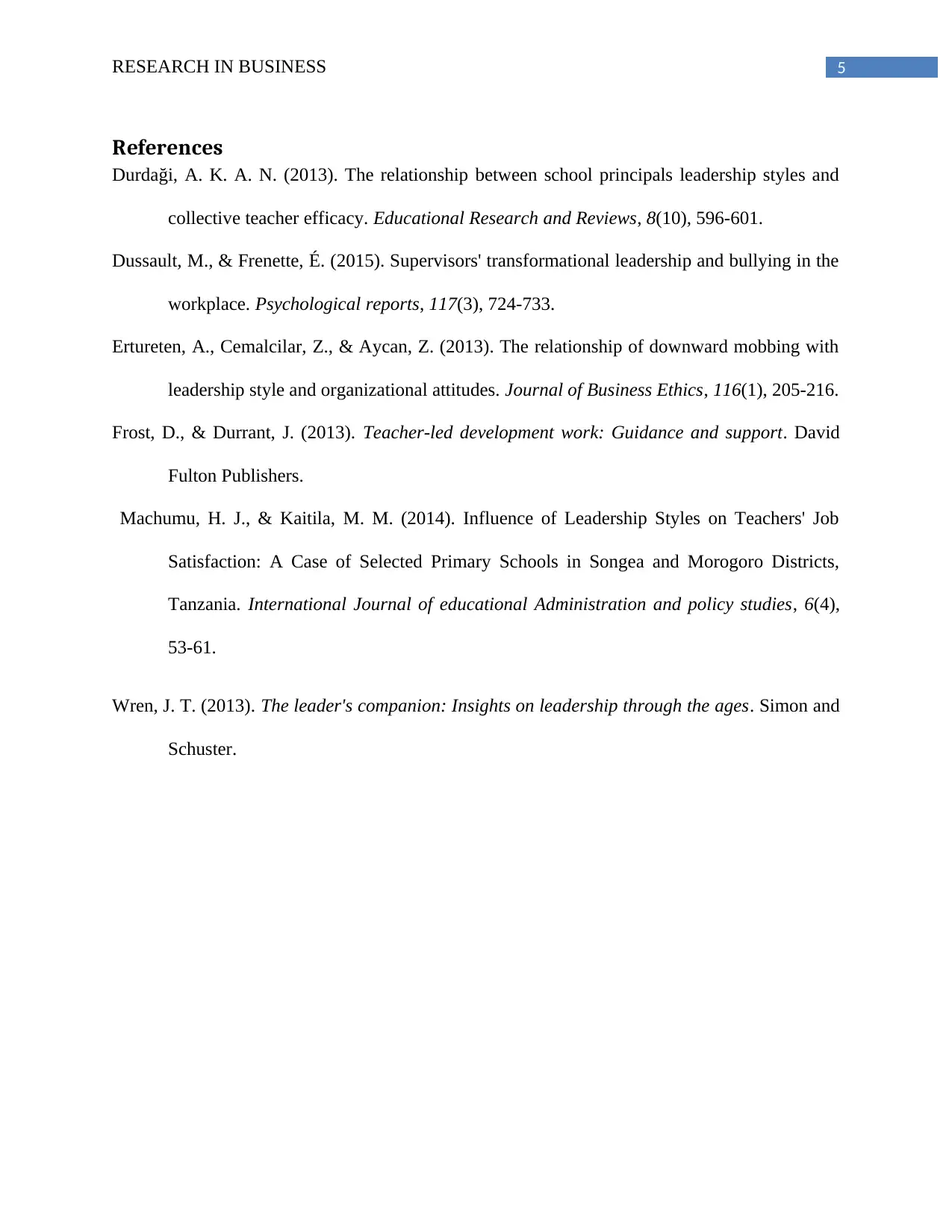Teacher Leadership Style & Bullying in Australian Secondary Schools
VerifiedAdded on 2023/06/08
|6
|1003
|92
Report
AI Summary
This report investigates the extent to which teachers' leadership styles affect bullying in Australian secondary schools. It aims to identify the impact of teacher leadership styles on bullying, evaluate factors encouraging bullying, assess approaches to identify causes and effects, and recommend suitable measures for overcoming bullying issues. The methodology includes a literature review of scholarly articles and journals, along with data collection through survey questionnaires from students and interviews with school managers and teachers. Secondary data sources, such as journals and websites, are analyzed using SPSS to present data in graphs and tables, providing a comprehensive case study analysis. The research emphasizes the significance of teacher leadership in preventing bullying and fostering a positive school environment.

Running head: RESEARCH IN BUSINESS
Research in business
To what extent does teachers’ leadership style affect bullying in Schools: Case of Australian
Secondary Schools
Name of student
Name of University
Author note
Research in business
To what extent does teachers’ leadership style affect bullying in Schools: Case of Australian
Secondary Schools
Name of student
Name of University
Author note
Paraphrase This Document
Need a fresh take? Get an instant paraphrase of this document with our AI Paraphraser

1RESEARCH IN BUSINESS
Table of Contents
1. Introduction (Problem statement)................................................................................................3
2. Project aims and objectives.........................................................................................................3
Objectives:...................................................................................................................................4
3. A brief methodology....................................................................................................................4
Literature review..........................................................................................................................4
Data collection.............................................................................................................................4
4. Secondary source of data presentation and analysis....................................................................5
References........................................................................................................................................6
Table of Contents
1. Introduction (Problem statement)................................................................................................3
2. Project aims and objectives.........................................................................................................3
Objectives:...................................................................................................................................4
3. A brief methodology....................................................................................................................4
Literature review..........................................................................................................................4
Data collection.............................................................................................................................4
4. Secondary source of data presentation and analysis....................................................................5
References........................................................................................................................................6

2RESEARCH IN BUSINESS
Title: To what extent does teachers’ leadership style affect bullying in Schools: Case of
Australian Secondary schools
1. Introduction (Problem statement)
Bullying is a common problem faced at schools and the children have often become the
subject or harm, abuse or negligence. Due to this, often the children face mental issues and even
may not concentrate on their studies properly, which can affect their physical and mental health
and wellbeing. The organizational commitment is dependent on the leadership roles and
responsibilities and thus the impact of teacher is high as well (Frost & Durrant, 2013). The
leadership behaviors of teachers are considered as most significant and indicator of preventing
bullying at schools and ensuring that the organizational performance and efficiency are improved
gradually (Machumu & Kaitila, 2014). It is also found that laissez faire leadership style of
teachers increase the risks of safety and level of conflicts between the students, which can lead to
bullying. It can create a stressful environment as well as affect the organizational performance. It
is important to make sure that the leader remains calm and possess good qualities to listen to the
students’ queries and take steps with proper consultation with the higher authorities to prevent
bullying and discrimination within the schools (Ertureten, Cemalcilar & Aycan, 2013). The
leadership styles of teachers have influenced the organizational commitment and can impact the
mobbing level to make sure that the organization is fully committed to excellent performance
and overcoming the issues like bullying at schools.
Title: To what extent does teachers’ leadership style affect bullying in Schools: Case of
Australian Secondary schools
1. Introduction (Problem statement)
Bullying is a common problem faced at schools and the children have often become the
subject or harm, abuse or negligence. Due to this, often the children face mental issues and even
may not concentrate on their studies properly, which can affect their physical and mental health
and wellbeing. The organizational commitment is dependent on the leadership roles and
responsibilities and thus the impact of teacher is high as well (Frost & Durrant, 2013). The
leadership behaviors of teachers are considered as most significant and indicator of preventing
bullying at schools and ensuring that the organizational performance and efficiency are improved
gradually (Machumu & Kaitila, 2014). It is also found that laissez faire leadership style of
teachers increase the risks of safety and level of conflicts between the students, which can lead to
bullying. It can create a stressful environment as well as affect the organizational performance. It
is important to make sure that the leader remains calm and possess good qualities to listen to the
students’ queries and take steps with proper consultation with the higher authorities to prevent
bullying and discrimination within the schools (Ertureten, Cemalcilar & Aycan, 2013). The
leadership styles of teachers have influenced the organizational commitment and can impact the
mobbing level to make sure that the organization is fully committed to excellent performance
and overcoming the issues like bullying at schools.
⊘ This is a preview!⊘
Do you want full access?
Subscribe today to unlock all pages.

Trusted by 1+ million students worldwide

3RESEARCH IN BUSINESS
2. Project aims and objectives
The aim of the project is to highlight the importance of teacher’s leadership style
affecting the bullying at the secondary schools in Australia.
Objectives:
To identify the impact of teacher’s leadership styles on the bullying at the Australian
secondary schools
To evaluate the various factors that may encourage bullying at schools
To assess the approaches needed to identify the cause and effect of bullying and
implement remedial measures
To recommend various options suitable for overcoming the bullying issues at the
Australian secondary schools
3. A brief methodology
Literature review
From the information provided the scholarly articles, it has been found that the bullying
at schools nowadays is a common cause of conflicts and negative behaviors among the students.
It has not only affected their physical and mental health or wellbeing, but also has resulted in
deteriorating their educational performance. The literature review has been done by assessing
various scholarly articles and journals to ensure that proper data and information are collected to
move on the next stage, i.e., the research methodology (Dussault & Frenette, 2015).
2. Project aims and objectives
The aim of the project is to highlight the importance of teacher’s leadership style
affecting the bullying at the secondary schools in Australia.
Objectives:
To identify the impact of teacher’s leadership styles on the bullying at the Australian
secondary schools
To evaluate the various factors that may encourage bullying at schools
To assess the approaches needed to identify the cause and effect of bullying and
implement remedial measures
To recommend various options suitable for overcoming the bullying issues at the
Australian secondary schools
3. A brief methodology
Literature review
From the information provided the scholarly articles, it has been found that the bullying
at schools nowadays is a common cause of conflicts and negative behaviors among the students.
It has not only affected their physical and mental health or wellbeing, but also has resulted in
deteriorating their educational performance. The literature review has been done by assessing
various scholarly articles and journals to ensure that proper data and information are collected to
move on the next stage, i.e., the research methodology (Dussault & Frenette, 2015).
Paraphrase This Document
Need a fresh take? Get an instant paraphrase of this document with our AI Paraphraser

4RESEARCH IN BUSINESS
Data collection
The collection of primary and secondary data is important for conducting the research
project where the primary data is further classified into qualitative and quantitative data. The
quantitative data is collected by distributing survey questionnaires to few students and their
families, who are considered as respondents. Their responses are considered as quantitative data
while the qualitative data is obtained by conducting interviews with the managers and few of the
teachers of the organization to gather their responses regarding the issue of bullying at schools
(Durdaği, 2013). The sample size for data collection will be chosen as 40 students and 5
managers.
4. Secondary source of data presentation and analysis
The literature review is done by assessing the secondary data sources and for analyzing
the quantitative data collection process. The secondary sources of data are journals, articles,
newspapers, documents and internet websites consisting of relevant information about the
research topic (Wren, 2013). The analysis will be done with the SPSS tool and central tendencies
statistical tools are used to present the data in graphs and tables for easy understanding
considering the analysis of case study.
Data collection
The collection of primary and secondary data is important for conducting the research
project where the primary data is further classified into qualitative and quantitative data. The
quantitative data is collected by distributing survey questionnaires to few students and their
families, who are considered as respondents. Their responses are considered as quantitative data
while the qualitative data is obtained by conducting interviews with the managers and few of the
teachers of the organization to gather their responses regarding the issue of bullying at schools
(Durdaği, 2013). The sample size for data collection will be chosen as 40 students and 5
managers.
4. Secondary source of data presentation and analysis
The literature review is done by assessing the secondary data sources and for analyzing
the quantitative data collection process. The secondary sources of data are journals, articles,
newspapers, documents and internet websites consisting of relevant information about the
research topic (Wren, 2013). The analysis will be done with the SPSS tool and central tendencies
statistical tools are used to present the data in graphs and tables for easy understanding
considering the analysis of case study.

5RESEARCH IN BUSINESS
References
Durdaği, A. K. A. N. (2013). The relationship between school principals leadership styles and
collective teacher efficacy. Educational Research and Reviews, 8(10), 596-601.
Dussault, M., & Frenette, É. (2015). Supervisors' transformational leadership and bullying in the
workplace. Psychological reports, 117(3), 724-733.
Ertureten, A., Cemalcilar, Z., & Aycan, Z. (2013). The relationship of downward mobbing with
leadership style and organizational attitudes. Journal of Business Ethics, 116(1), 205-216.
Frost, D., & Durrant, J. (2013). Teacher-led development work: Guidance and support. David
Fulton Publishers.
Machumu, H. J., & Kaitila, M. M. (2014). Influence of Leadership Styles on Teachers' Job
Satisfaction: A Case of Selected Primary Schools in Songea and Morogoro Districts,
Tanzania. International Journal of educational Administration and policy studies, 6(4),
53-61.
Wren, J. T. (2013). The leader's companion: Insights on leadership through the ages. Simon and
Schuster.
References
Durdaği, A. K. A. N. (2013). The relationship between school principals leadership styles and
collective teacher efficacy. Educational Research and Reviews, 8(10), 596-601.
Dussault, M., & Frenette, É. (2015). Supervisors' transformational leadership and bullying in the
workplace. Psychological reports, 117(3), 724-733.
Ertureten, A., Cemalcilar, Z., & Aycan, Z. (2013). The relationship of downward mobbing with
leadership style and organizational attitudes. Journal of Business Ethics, 116(1), 205-216.
Frost, D., & Durrant, J. (2013). Teacher-led development work: Guidance and support. David
Fulton Publishers.
Machumu, H. J., & Kaitila, M. M. (2014). Influence of Leadership Styles on Teachers' Job
Satisfaction: A Case of Selected Primary Schools in Songea and Morogoro Districts,
Tanzania. International Journal of educational Administration and policy studies, 6(4),
53-61.
Wren, J. T. (2013). The leader's companion: Insights on leadership through the ages. Simon and
Schuster.
⊘ This is a preview!⊘
Do you want full access?
Subscribe today to unlock all pages.

Trusted by 1+ million students worldwide
1 out of 6
Related Documents
Your All-in-One AI-Powered Toolkit for Academic Success.
+13062052269
info@desklib.com
Available 24*7 on WhatsApp / Email
![[object Object]](/_next/static/media/star-bottom.7253800d.svg)
Unlock your academic potential
Copyright © 2020–2025 A2Z Services. All Rights Reserved. Developed and managed by ZUCOL.





